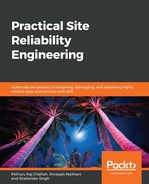The cloud paradigm brings the much-needed flexibility of assigning resources needed to support demand from cloud users. Establishing and enforcing appropriate policies and rules are important for assigning cloud resources to business applications and IT services. However, the effectiveness of policy management depends on the visibility that organizations have about their cloud resources. Organizations need to have the capability to create, modify, monitor, and update the policies. In short, cloud monitoring tools need to have the previously mentioned cloud-specific features, functionalities, and facilities to realize all the cloud-sponsored benefits.
As organizations deploying cloud computing services trust third-party providers to fulfil the quality of service (QoS) attributes and performance, as quoted previously, is the key QoS parameter. The monitoring tool has to monitor not only the actual levels of performance, as experienced by business users, but also enable it to help the users to do the root-cause analysis (RCA) for all those performance degradation problems. The monitoring tool has to have the capability for monitoring application response times, service availability, and page-load times. Peak time traffic monitoring is also required. In addition, the monitoring tools need to be able to handle hybrid and multi-cloud environments that include traditional IT infrastructures.
In conclusion, it is paramount to deploy monitoring and management tools to effectively and efficiency run cloud environments, wherein thousands of computing, storage, and network solutions are running. The logs, operations, scalability, performance, availability, stability, and reliability data showcased through a 360-degree view empowers administrators and manages counter measures immediately to ensure business continuity. The manage engine applications manager (https://www.manageengine.com) allows organizations to monitor levels of SLA achievements for cloud services. This tool also provides troubleshooting and resolution capabilities across cloud environments (private, public, and hybrid).
The key characteristics of this tool are vividly illustrated through the following diagram:

Here are some of the key features and capabilities we need to properly monitor for modern cloud-based applications and infrastructures (https://newrelic.com/):
- Firstly, the ability to capture and query events and traces in addition to data aggregation is essential. When a customer buys something online, the buying process generates a lot of HTTP requests. For proper end-to-end cloud monitoring, we need to see the exact set of HTTP requests the customer makes while completing the purchase: each of the individual product detail pages, the add-to-cart POST requests, the cart view page, the billing and shipping POST requests, and the final submit order page. The ability to capture the raw transaction data is important in cloud deployments, where each request often goes through a number of dynamic components from a web or mobile browser to a CDN, followed by a load balancer, before reaching the application and the microservices.
There are message brokers/queues involved in-between in completing the transaction. Thus, any monitoring system has to have the capability to quickly identify bottlenecks and understand the relationships among different components. The solution has to give the exact response time of each component for each transaction. Critical metadata such as error traces and custom attributes ought to be made available to enhance trace and event data. By segmenting the data via the user and business-specific attributes, it is possible to prioritize improvements and sprint plans to optimize for those customers.
- Secondly, the monitoring system has to be blessed with the ability to monitor a wide variety of cloud environments (private, public, and hybrid). There are a number of public cloud service providers (AWS, Azure, IBM, Google, and so on). The solution has to have all the integration brokers/plug-ins in one place to simplify and speed up the cloud connectivity and integration. The plug-ins need to be there for most of the leading services, such as Elastic Load Balancer, EC2, Lambda, DynamoDB, RDS, and CloudFront.
- Thirdly, the monitoring solution has to scale for any emergency. Cloud environments are extremely and enviously dynamic. The users and data loads are changing rapidly. The number of infrastructural components being used on special occasions is growing exponentially, and hence the availability, stability, and scalability of monitoring systems have to be equally ensured. Increasingly, monitoring solutions are being provided as multi-tenant software. The SaaS model is easy, as it is being updated, patched, monitored, and managed by the provider.
